Habilitation, PhD and Master Thesis
- Molekulare Knoten – Computersimulationen zu Selbstverschlaufungen in Polymeren, DNA und Proteinen
Habilitationsschrift (2016), Institut für Physik, Johannes Gutenberg-Universität Mainz.
- Monte-Carlo-Simulationen zum Phasen- und Keimbildungsverhalten von Polymerlösungen
Dissertation (2003), Institut für Physik, Johannes Gutenberg-Universität Mainz.
- Development of a Magneto-Optical Kerr Probe for Thin Film Characterization
Master thesis (1999), Department of Physics, Louisiana State University, Baton Rouge, USA.
Editorial activities
E2. Heterogeneous nucleation and microstructure formation: Steps towards a system and scale
bridging understanding
H. Emmerich, P. Virnau, G. Wilde, R. Spatschek (eds)
Physical Journal – Special Topics, volume 223 (2014).
E1. Computer Simulations on Graphics Processing Units
M. Weigel, A. Arnold, P. Virnau (eds)
European Physical Journal – Special Topics, volume 210 (2012).
Peer-reviewed publications
94. Free energy barriers for crystal nucleation from fluid phases
P. Koss, A. Statt, P. Virnau, K. Binder
Phys. Rev. E. 96, 042609 (2017)
93. Are there knots in chromosomes?
J.Siebert, A. Kivel, L. Atkinson, T. Stevens, E. Laue, P. Virnau
Polymers 9, 317 (2017).
92. Estimation of the critical behaviour in an active colloidal system with Vicsek-like interactions
B. Trefz, J. Siebert, T. Speck, K. Binder, P. Virnau
Chem. Phys. 146, 074901 (2017).
91. Phase behaviour of active Brownian disks, spheres and dimers
J. Siebert, J. Letz, T. Speck, P. Virnau
Soft Matter 13, 1020 (2017).
90. Entropic Interactions between two knots on a semiflexible polymer
D. Richard, S. Stalter, J. Siebert, F. Rieger, B. Trefz, P. Virnau
Polymers 9, 55 (2017).
89. Monte Carlo study of knots in long double-stranded DNA chains
F. Rieger, P. Virnau
PLoS Comp. Biol. 12, e1005029 (2016).
88. Overview: Understanding nucleation phenomena from simulations of lattice gas models
K. Binder, P. Virnau
Chem. Phys. 145, 211701 (2016).
87. Semiflexible polymers under good solvent conditions interacting with repulsive walls
S.A. Egorov, A. Milchev, P. Virnau, K. Binder
J. Chem. Phys. 144, 174902 (2016).
86. Knots in finite memory walks
E. Horwath, N. Clisby, P. Virnau
Phys.: Conf. Ser. 750, 012010 (2016).
85. The ensemble switch method and related approaches to obtain interfacial free energies
between coexisting phases from simulations: a brief review
P. Virnau, F. Schmitz, K. Binder
Molecular Simulation 42 SI, 549 (2016).
84. Activity mediated phase separation: Can we understand phase behaviour of the nonequilibrium
problem from an equilibrium approach
B. Trefz, S.K. Das, S.A. Egorov, P. Virnau, K. Binder
Chem. Phys. 114, 144902 (2016).
83. A new insight into the isotropic-nematic phase transition in lyotropic solutions of semiflexible
polymers: density-functional theory tested by molecular dynamics
S.A. Egorov, A. Milchev, P. Virnau, K. Binder
82. Crystal nuclei in melts: a Monte Carlo simulation of a model for attractive colloids
A. Statt, P. Virnau, K. Binder
Mol. Phys. 113, 2556 (2015).
81. Scaling behaviour of topologically constrained polymer rings in a melt
B. Trefz, P. Virnau
Phys.: Condens. Matter 27, 354110 (2015).
80. The ensemble switch method for computing interfacial tensions
F. Schmitz, P. Virnau
Chem. Phys. 142, 144108 (2015).
79. Finite-size effects on liquid-solid phase coexistence and the estimation of crystal
nucleation barriers
A. Statt, P. Virnau, K. Binder
Phys. Rev. Lett. 114, 026101 (2015).
78. Sequence determines degree of knottedness in a coarse-grained protein model
Wüst, D. Reith, P. Virnau
Phys. Rev. Lett. 114, 028102 (2015).
Chosen as Editor’s suggestion.
77. Anisotropic interfacial tension, contact angles, and line tensions: A graphics-processing-unit-
based Monte Carlo study of the Ising model
B.J. Block, S. Kim, P. Virnau, K. Binder
Phys. Rev. E 90, 062106 (2014).
76. Perspective: The Asakura Oosawa model: A colloid prototype for bulk and interfacial
phase behaviour
K. Binder, P. Virnau, A. Statt
Chem. Phys. 141, 140901 (2014).
75. Logarithmic finite-size effects on interfacial free energies: Phenomenological theory
and Monte Carlo studies
F. Schmitz, P. Virnau, K. Binder
Phys. Rev. E 90, 012128 (2014).
74. Determination of origin and magnitude of logarithmic finite-size effects on interfacial tension:
role of interfacial fluctuations and domain breathing (erratum)
F. Schmitz, P. Virnau, K. Binder
Phys. Rev. Lett. 112, 239902 (2014).
73. How molecular knots can pass through each other
B. Trefz, J. Siebert, P. Virnau
Proc. Nat. Acad. Sci: USA 111, 7948 (2014).
72. Phase behaviour of active swimmers in depletants: Molecular dynamics and integral
equation theory
S.K. Das, S. Egorov, B. Trefz, P. Virnau, K. Binder
Phys. Rev. Lett. 112, 198301 (2014).
71. Determination of the origin and magnitude of logarithmic finite-size effects on interfacial tension:
role of interfacial fluctuations and domain breathing
F. Schmitz, P. Virnau, K. Binder
Phys. Rev. Lett. 112, 125701 (2014).
70. Computer simulation of heterogeneous nucleation of colloidal crystals at planar walls
B.J. Block, D. Deb, F. Schmitz, A. Statt, A. Tröster, A. Winkler, T. Zykova-Timan, P. Virnau, K. Binder
EPJ-ST 223, 347 (2014).
69. Structure formation of polymeric building blocks: complex polymer architectures
K. Binder, H.-J. Butt, G. Floudas et al.
Adv. Poly. Sci. 260, 115-210 (2014).
68. Polymer dynamics in polymer-solid in a polymer-solid interphase: Molecular dynamics
simulations of 1,4-polybutadien at a graphite surface
M. Solar, L. Yelash, P. Virnau, K. Binder, W. Paul
Soft Mater. 12, S80-S89 (2014).
67. Stick-slip motion and plastic flow of a two-dimensional colloidal crystal confined to moving
corrugated rigid boundaries
D. Wilms, P. Virnau, K. Binder
Mol. Phys. 111, 22 (2013).
66. Computer simulations of structure, dynamics, and phase behaviour of colloidal
fluids in confined geometry and under shear
A.Winkler, D. Winter, P. Chaudhuri, A. Statt, P. Virnau, J. Horbach, K. Binder
EPJ-ST 222, 2787 (2013).
65. Effects of boundaries on structure formation in low-dimensional colloid model
systems near the liquid-solid-transition in equilibrium and in external fields and under shear
Deutschländer, K. Franzrahe, B. Heinze et al.
EPJ-ST 222, 2973 (2013).
64. Monte Carlo tests of nucleation concepts in the lattice gas model
F. Schmitz, P. Virnau, K. Binder
Phys. Rev. E 87, 053302 (2013).
63. Influence of chain stiffness on knottedness in single polymers
P. Virnau, F. Rieger, D. Reith
Biochem. Soc. Trans. 41, 528 (2013).
62. Phase transitions and phase equilibria in spherical confinement
A.Winkler, A. Statt, P. Virnau, K. Binder
Phys. Rev. E 87, 032307 (2013).
61. Hydrodynamic mechanisms of spinodal decomposition in confined colloid-polymer mixtures:
Amultiparticle collision dynamics study /strong> A. Winkler, P. Virnau, K. Binder, R.G. Winkler, G. Gompper
Chem. Phys. 138, 054901 (2013).
60. Beyond the van der Waals loop: What can be learned from simulating Lennard-Jones fluids inside
the region of phase coexistence
K. Binder, B.J. Block, P. Virnau, A. Tröster
Am. J. Phys. 80, 1099 (2012).
59. Motion, relaxation dynamics and diffusion processes in two-dimensional colloidal crystals
confined between walls
D. Wilms, P. Virnau, I.K. Snook, K. Binder
Phys. Rev. E 86, 051404 (2012).
58. Controlling the wetting properties of the Asakura-Oosawa model and applications to spherical
confinement
A. Statt, A. Winkler, P. Virnau, K. Binder
Phys. Condens. Matter 24, 464122 (2012).
57. Effects of confinement and external fields on structure and transport
in colloidal dispersions in reduced dimensionality
D. Wilms, S. Deutschländer, U. Siems, K. Franzrahe, P. Henseler, P. Keim, N. Schwierz, P. Virnau,
K. Binder, G. Maret, P. Nielaba
Phys. Condens. Matter 24, 464119 (2012).
56. Confinement-induced screening of hydrodynamic interactions and spinodal decomposition:
Multiscale simulations of colloid-polymer mixtures
A. Winkler, P. Virnau, K. Binder, R.G. Winkler, G. Gompper
EPL 100, 46003 (2012).
55. Accelerated GPU simulation of compressible flow by discontinuous evolution garlerkin method
B.J. Block, M. Lukacova-Medvidova, P. Virnau, L. Yelash
EPJ ST 210, 119 (2012).
54. Methods to compute pressure and wall tension in fluids containing hard particles
D. Deb, D. Wilms, A. Winkler, P. Virnau, K. Binder
Int. J. Mod. Phys. C 23, 1240011 (2012).
53. Langevin dynamics simulations of a two-dimensional colloidal crystal under
confinement and shear
D. Wilms, P. Virnau, S. Sengupta, K. Binder
Phys. Rev. E 85, 061406 (2012).
52. Effective stiffening of DNA due to nematic ordering causes DNA molecules
packed in phage capsids to preferentially form torus knots
D.Reith, P. Cifra, A. Stasiak, P. Virnau
Nucl. Acids. Res. 40, 5129 (2012).
51. Computer simulation studies of chain dynamics in polymer brushes
D. Reith, A. Milchev, P. Virnau, K. Binder
Macromolecules 45, 4381 (2012).
50. Three-step decay of time correlations at polymer-solid interfaces
L. Yelash, P. Virnau, K. Binder, W. Paul
EPL 98, 28006 (2012).
49. Spinodal decomposition of polymer solutions: molecular dynamics simulations
of the two-dimensional case
D. Reith, K. Bucior, L. Yelash, P. Virnau, K. Binder
Phys. Condens. Matter 24, 115102 (2012).
48. Numerical approaches to determine the interface tension of curved interfaces
from free energy calculations
A. Troester, M. Oettel, B. Block, P. Virnau, K. Binder
Chem. Phys. 136, 064709 (2012).47
47. Active non-linear micro-rheology in a glass-forming Yukawa fluid
D. Winter, J. Horbach, P. Virnau, K. Binder
Phys. Rev. Lett. 108, 028303 (2012).
46. Structures and folding pathways of topologically knotted proteins
P. Virnau, A. Mallam, S. Jackson
Topical Review in J. Phys. Condens. Matter 23, 033101 (2011).
45. Computer simulations and coarse-grained molecular models predicting
the equation of state of polymer solutions
K. Binder, B. Mognetti, W. Paul, P. Virnau, L. Yelash
Adv. Polym. Sci. 238, 329 (2011).
44. GPU based molecular dynamics simulations of polymer rings in concentrated solution:
structure and scaling
D. Reith, L.A. Mirny, P. Virnau
Prog. Theor. Phys. Supp. 191, 135 (2011).
43. Anomalous structure and scaling of ring polymer brushes
D. Reith, A. Milchev, P. Virnau, K. Binder
EPL 95, 28003 (2011)..
42. Spurious character of singularities associated with phase transitions in cylindrical pores
K. Binder, P. Virnau, D. Wilms, A. Winkler
Eur. Phys. J – Spec Top 197, 227 (2011).
41. Hard sphere fluids confined between soft repulsive walls: A comparative study using Monte Carlo
and density functional methods
D. Deb, A. Winkler, M.H. Yamani, M. Oettel, P. Virnau, K. Binder
Chem. Phys. 134, 214706 (2011).
40. Monte Carlo simulations of a single polystyrene chain in spherical confinement
D. Reith, P. Virnau
Comp. Phys. Commun. 182, 1945 (2011)
39. Monte Carlo simulations of the 2d-Ising model in the geometry of a long stripe
D. Wilms, A. Winkler, P. Virnau, K. Binder
Comp. Phys. Commun. 182, 1892 (2011).
38. Confined binary two-dimensional colloidal crystals: Monte Carlo simulation of crack formation
Medina, P. Virnau, K. Binder
Phys. Condens. Matter 23, 035105 (2011).
37. Molecular simulation of polymer blends and melts: Methods, phase behaviour, interfaces
and and surfaces
P. Virnau, K. Binder, H. Heinz, T. Kreer, M. Müller Vol. 1, 1 in Encyclopedia of Polymer Blends,
A.I. Isayev (ed.), Wiley-VCH, Weinheim (2010).
36. Rounding of phase transitions in cylindrical pores
D. Wilms, A. Winkler, P. Virnau, K. Binder
Phys. Rev. Lett. 105, 045701 (2010).
35. Curvature dependence of surface free energy of liquid drops and bubbles: A simulation study
B.J. Block, S.K. Das, M. Oettel, P. Virnau, K. Binder
Chem. Phys. 133, 154702 (2010), als Research Highlight ausgezeichnet.
34. Capillary condensation in cylindrical pores: Monte Carlo study of the interplay of surface
and finite size effects
A. Winkler, D. Wilms, P. Virnau, K. Binder
Chem. Phys. 133, 164702 (2010).
33. Finite-size scaling analysis of the anisotropic critical behavior of the two-dimensional
Ising model under shear
D. Winter, P. Virnau, J. Horbach, K. Binder
EPL 91, 60002 (2010).
32. A slow process in confined polymer melts: layer exchange dynamics at a polymer solid interface
Yelash, P. Virnau, K. Binder, W. Paul,
Phys. Rev. E 82, 050801 (2010)
31. Multi-GPU Accelerated Monte Carlo Simulation of the 2D Ising Model
B.J. Block, P. Virnau, T. Preis
Comp. Phys. Commun. 181, 1549 (2010).
30. A Stevedore’s protein knot
Bölinger, J. Sulkowska, H.-P. Hsu, L. Mirny, M. Kardar, J.Onuchic, P. Virnau
PLoS Comp. Biol. 6, e1000731 (2010).
29. Conformational properties of polymer mushrooms under spherical and cylindrical confinement
Wang, P. Virnau, K. Binder
Macromolecular Theory and Simulations 19, 258 (2010).
28. A combined molecular dynamics and Monte Carlo study of the approach towards phase
separation in colloid-polymer mixtures
Zausch, J. Horbach, P. Virnau, K. Binder
Phys. Condens. Matter 22, 104120 (2010).27.
27. Implementation and performance analysis of bridging Monte Carlo moves for off-lattice single
chain polymers in globular states
D. Reith, P. Virnau
Comp. Phys. Commun. 181, 800 (2010)
26. Monte Carlo test of the classical theory for heterogeneous nucleation barriers
A. Winter, P. Virnau, K. Binder
Phys. Rev. Lett. 103, 225703 (2009).
25. Methods to extract interfacial free energies of flat and curved interfaces from computer
simulations
P. Schrader, P. Virnau, D. Winter, T, Zykova-Timan, K. Binder
Eur. Phys. J. – Spec. Top. 177, 103 (2009).
24. Heterogeneous nucleation at a wall near a wetting transition:
Monte Carlo test of the classical theory
A. Winter, P. Virnau, K. Binder
Phys. Condens. Matter 21, 464118 (2009).
23. Accelerated fluctuation analysis by graphic cards and complex pattern formation in Econophysics
T. Preis, P. Virnau, W. Paul, J.J. Schneider
New J. Phys. 11, 093024 (2009).
22. GPU accelerated Monte Carlo simulation of the 2D and 3D Ising model
T. Preis, P. Virnau, W. Paul, J.J. Schneider
Comp. Phys. 228, 4468 (2009).
21. Simulation of vapor-liquid coexistence in finite volumes: A method to compute the surface free
energy of droplets
Schrader, P. Virnau, K. Binder
Phys. Rev. E 79, 061104 (2009).
20. Coarse-graining dipolar interactions in simple fluids and polymer solutions:
Monte Carlo studies of the phase behavior
B.M. Mognetti, P. Virnau, L. Yelash, K. Binder
Phys. Chem. Chem. Phys. 11, 1923 (2009).
19. Statics and dynamics of colloid polymer mixtures near their critical point of
Phase separation: a computer simulation study
J. Zausch, P. Virnau, J. Horbach, K. Binder
Chem. Phys. 130, 064906 (2009)
18. >Coarse-grained models for fluids and their mixtures: Comparison of Monte Carlo
studies of their phase behavior with perturbation theory and experiment
B.M. Mognetti, P. Virnau, L. Yelash, W. Paul, K. Binder, M. Müller, L.G. MacDowell
Chem. Phys. 130, 044101 (2009).
17. Structure and pair correlations of a simple coarse grained model for supercritical carbon dioxide
B.M. Mognetti, M. Oettel, P. Virnau, L. Yelash, K. Binder
Mol. Phys. 107, 331 (2009).
16. From atomistic modeling of macromolecules towards equations of state for polymer solutions and
melts: How important is the accurate description of the local structure?
K. Binder, W. Paul, P. Virnau, L. Yelash, M. Müller, L.G. MacDowell
Chapter 26, 399 in Coarse-Graining of Condensed Phase and Biomolecular Systems, G.A.
Voth (ed.),
CRC Press, Boca Raton, FL (2008).
15. Decomposition of polymer solutions: A parallelized molecular dynamics simulation
L. Yelash, P. Virnau, W. Paul, K. Binder
Phys. Rev. E 78, 031801 (2008).
14. Efficient prediction of thermodynamic properties of quadrupolar fluids from simulation of a coarse-
grained model: The case of carbon dioxide
B.M. Mognetti, L. Yelash, P. Virnau, W. Paul, K.Binder, M. Müller, L.G. MacDowell
Chem. Phys. 128, 104501 (2008).
13. Efficient prediction of thermodynamic properties of quadrupolar fluids from simulation
of a coarse-grained model: The case of carbon dioxide
B.M. Mognetti, L. Yelash, P. Virnau, W. Paul, K.Binder, M. Müller, L.G. MacDowell
Chem. Phys. 128, 104501 (2008).
12. Spherically averaged versus angle-dependent interactions in quadrupolar fluids
B.M. Mognetti, M. Oettel, L. Yelash, L, P. Virnau, W. Paul, K. Binder
Phys. Rev. E 77, 041506 (2008).
11. Protein knot server: detection of knots in protein structures
Kolesov, P. Virnau, L.A. Mirny, M. Kardar
Nucl. Acids Res. 35, W425 (2007).
10. Intricate knots in proteins: function and evolution
P. Virnau, L.A. Mirny, M. Kardar
PLoS Comp. Biol. 2, e122 (2006).
9. Capturing knots in polymers
Eingeladener Beitrag anlässlich eines bei der APS-Frühjahrstagung in Los Angeles 2005 an mich
verliehenen Posterpreises
P. Virnau, M. Kardar, Y. Kantor
Chaos 15, 041103 (2005).
8. Polymer+solvent systems: phase diagrams, interface free energies, and nucleation
K. Binder, M. Müller, P. Virnau, L.G. MacDowell
Adv. Polym. Sci. 173, 1 (2005).
7. Calculation of free energy through successive umbrella sampling
P. Virnau, M. Müller
Chem. Phys. 120, 10925 (2004).
6. Phase behavior of n-alkanes in supercritical solution
P. Virnau, M. Müller, L.G. MacDowell, K. Binder
Chem. Phys. 121, 2169 (2004).
5. Phase separation kinetics in compressible polymer solutions: computer simulation
of the early stages
P. Virnau, M. Müller, L.G. MacDowell, K. Binder
New J. Phys. 6, 7 (2004).
4. The evaporation/condensation transition of liquid droplets
L.G. MacDowell, P.Virnau, M. Müller, K. Binder
Chem. Phys. 120, 5293 (2004).
3. Phase diagrams of hexadecane-CO2 mixtures from histogram-reweighting Monte Carlo
P. Virnau, M. Müller, L.G. MacDowell, K. Binder
Comp. Phys. Commun. 147, 378 (2002).
2. Critical lines and phase coexistence of polymer solutions: A quantitative comparison between
Wertheim’s thermodynamic perturbation theory and computer simulations
L.G. MacDowell, P. Virnau, M. Müller, K. Binder
Chem. Phys. 117, 6360 (2002).
1. Interface properties and bubble nucleation in compressible mixtures containing polymers
M. Müller, L.G. MacDowell, P. Virnau, and K. Binder
Chem. Phys. 117, 5480 (2002).
Tagungsberichte (ohne Begutachtung) und sonstige Veröffentlichungen
P22. Reduced-order hybrid multiscale method combining the Molecular Dynamics
and the Discontinous-Galerkin method
Emamy, M. Lukáčová-Medviďová, S. Stalter, P. Virnau, L. Yelash
VII Int. Conf. Comput. Methods Coupled Problems in Science and Engineering,
Coupled Problems 2017, 62-76
Eds.: Papadrakakis et al., (2017).
P21. Molecular dynamics simulations in hybrid particle-continuum schemes: Pitfalls and caveats
S. Stalter, L. Yelash, N. Emamy, A. Statt, M. Hanke, M. Lukáčová-Medviďová, P. Virnau
Comp. Phys. Commun. 224, 198-208 (2017).
P20. Estimation of nucleation barriers from simulations of crystal nuclei surrounded
by fluid in quilibrium A. Statt, P. Koß, P. Virnau, K. Binder
W.E. Nagel et al (eds.) High Performance Computing in Science and Engineering ’16, (2016).
P19. Monte Carlo simulation of crystal-liquid phase coexistence
A. Statt, F. Schmitz, P. Virnau, K. Binder
W.E. Nagel et al (eds.) High Performance Computing in Science and Engineering ’15, 75 (2015).
P18. Investigation of finite-size effects in the determination of interfacial tensions
F. Schmitz, A. Statt, P. Virnau, K. Binder
W.E. Nagel et al. (eds.) High Performance Computing in Science and Engineering ’14, 5,
Springer-Verlag (2014).
P17. Nonlinear response of single particles in glassforming fluids to external forces
K. Binder, J. Horbach, P. Virnau, D. Winter
Innovatives Supercomputing in Deutschland (inSiDE) 12, 49 (2014).
P16. Phase separation in colloid polymer mixtures under confinement
A. Statt, A. Winkler, P. Virnau, K. Binder
W.E. Nagel et al. (eds.) High Performance Computing in Science and Engineering ’13, 19,
Springer-Verlag (2013
P15. Phase separation in colloidal suspensions by collective growth of domains
A.Winkler, P. Virnau, K. Binder, R.G. Winkler, G. Gompper
Innovatives Supercomputing in Deutschland (inSiDE) 11, 30 (2013).
P14. Spinodal decomposition kinetics of colloid-polymer mixtures including
hydrodynamic interactions
A.Winkler, P. Virnau, K. Binder
W.E. Nagel et al. (eds.) High Performance Computing in Science and Engineering ’12, 29,
Springer-Verlag (2012).
P13. Structure and dynamics at polymer-solid interfaces: a molecular dynamics simulations of
1,4-polybutadiene at graphite
Paul, L. Yelash, P. Virnau, K. Binder, K. Binder, G. Münster, M. Kremer (eds.)
NIC Symposium 2012 Proceedings, 285 (2012).
P12. Monte Carlo simulation studies of interfacial free energies in colloidal suspensions
D. Deb, D. Wilms, A. Winkler, P. Virnau, K. Binder
K. Binder, G. Münster, M. Kremer (eds.)
NIC Symposium 2012 Proceedings, 235 (2012).
P11. Coil-globule transition and knottedness in homo- and heteropolymers
Bölinger, Hsiao-Ping Hsu, Peter Virnau
Bussei-Kenkyu 92-1, 62 (2009).
P10. Towards the quantitative prediction of the phase behavior of polymer solutions by computer
simulation
K. Binder,B.M. Mognetti,L.G. MacDowell,M. Oettel, W. Paul,P. Virnau, L. Yelash
Macromolecular Symposia 278, 1 (2009).
P9. Simulationen auf Grafikkarten: vom Videospiel zur Materialforschung
Forschungsmagazin der Uni Mainz
Oettel, P. Virnau
Natur und Geist 2/2009, 8 (2009).
P8. Knots in Macromolecular Systems: concepts and challenges
P. Virnau
NIC Series Volume 34: From Computational Biophysics to Systems Biology, 287,
U.H.E. Hansmann, J. Meinke, S. Mohanty, O. Zimmermann (eds), (2007).
P7. A successive umbrella sampling algorithm to sample and overcome free energy barriers
P. Virnau, M. Müller
Computer simulation studies in Condensed Matter Physics XVII, 151
D.P. Landau, S.P. Lewis, H.B. Schüttler (eds.), Springer-Verlag (2006).
strong>P6. El intrigante lazo de Van der Waals
Von L.G. MacDowell geschriebener Beitrag im Journal der spanischen chemischen Gesellschaft
L.G. MacDowell, P. Virnau
An. Quim. 101, 19 (2005).
P5. Simulation of transport in partially miscible binary fluids: Combination of Semigrandcanonical
Monte Carlo and Molecular Dynamics Methods
K. Binder, S.K. Das, J. Horbach, M. Müller, R. Vink, P. Virnau
Multiscale Modelling and Simulation, S. Attinger, P. Koumoutsakos (eds.), Springer-Verlag (2004).
P4. The droplet evaporation/condensation transition in a finite volume
P. Virnau, L.G. MacDowell, M. Müller, K. Binder
Computer Simulation Studies in Condensed Matter Physics XVI, 129
D.P. Landau, S.P. Lewis, H.B. Schüttler (eds.), Springer-Verlag (2003).
P3. How do droplets depend on the system size? Droplet condensation and nucleation in small
simulation cells
P. Virnau, L.G. MacDowell, M. Müller, K. Binder
High Performance Computing in Science and Engineering ‘04, 125
Krause, W. Jäger, M. Resch (eds.), Springer-Verlag (2003).
P2. Reduced-order hybrid multiscale method combining the Molecular Dynamics <br<
and the Discontinous-Galerkin method
Emamy, M. Lukáčová-Medviďová, S. Stalter, P. Virnau, L. Yelash
VII Int. Conf. Comput. Methods Coupled Problems in Science and Engineering,
Coupled Problems 2017, 62-76
Eds.: Papadrakakis et al., (2017).
P1. Molecular dynamics simulations in hybrid particle-continuum schemes: Pitfalls
and caveats
S. Stalter, L. Yelash, N. Emamy, A. Statt, M. Hanke, M. Lukáčová-Medviďová,
P. Virnau
Comp. Phys. Commun. 224, 198-208 (2017).
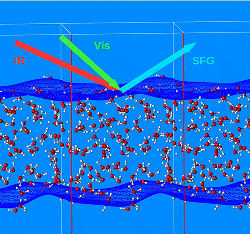 Confined water at nanoscale shows properties which are remarkably different from bulk. Vibrational Sum Frequency Generation Spectroscopy (VSFG) has contributed to a large extent to draw the attention on the new physical and chemical properties at interfaces, thanks to its ability to selectively probe non-centrosymmetric systems. However, the microscopic characterization of the VSFG spectra remains hard even with the development of some improvements like Phase-Sensitive VSFG. Molecular dynamics simulations can play a key role to provide a molecular interpretation of the spectra. In particular DFT-based simulations which do not require a priori parametrization, are particularly suitable to address the heterogeneous environment at interfaces. Our aim is to advance computational spectrscopy methods in order to provide a microscopic understanding of the special water structure and dynamics at interfaces. For more information, please contact
Confined water at nanoscale shows properties which are remarkably different from bulk. Vibrational Sum Frequency Generation Spectroscopy (VSFG) has contributed to a large extent to draw the attention on the new physical and chemical properties at interfaces, thanks to its ability to selectively probe non-centrosymmetric systems. However, the microscopic characterization of the VSFG spectra remains hard even with the development of some improvements like Phase-Sensitive VSFG. Molecular dynamics simulations can play a key role to provide a molecular interpretation of the spectra. In particular DFT-based simulations which do not require a priori parametrization, are particularly suitable to address the heterogeneous environment at interfaces. Our aim is to advance computational spectrscopy methods in order to provide a microscopic understanding of the special water structure and dynamics at interfaces. For more information, please contact 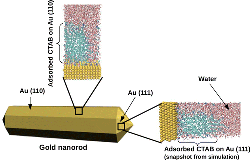 We investigate how the properties at the interface influence the crystal growth in a few selected example. In particular one topic is related to the understanding of the microscopic origin of the asymmetric growth mechanism in gold nanorods (Collaborators: C. Sönnichsen, Chemistry, JGU). The second topic is related to understanding how bio-polymers such as polyacrylate, poly-aspartate and poly-glutamate influence the crystalline phase, morphology and growth rate of calcium oxalate. Ab initio molecular dynamics study of the interactions of the water/mineral and water/polymer/mineral interfaces shed light on the biomineralization process and on the mechanisms responsible for its inhibition. For more information, please contact
We investigate how the properties at the interface influence the crystal growth in a few selected example. In particular one topic is related to the understanding of the microscopic origin of the asymmetric growth mechanism in gold nanorods (Collaborators: C. Sönnichsen, Chemistry, JGU). The second topic is related to understanding how bio-polymers such as polyacrylate, poly-aspartate and poly-glutamate influence the crystalline phase, morphology and growth rate of calcium oxalate. Ab initio molecular dynamics study of the interactions of the water/mineral and water/polymer/mineral interfaces shed light on the biomineralization process and on the mechanisms responsible for its inhibition. For more information, please contact 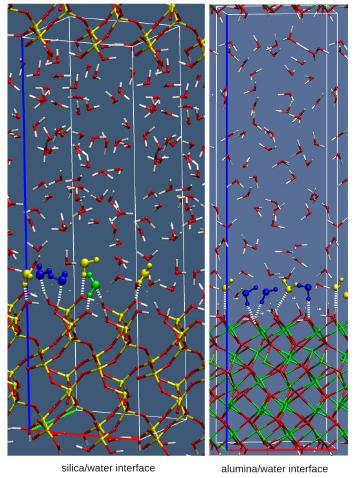 We aim to a detailed understanding of the molecular behaviour of the different solid–water interfaces, using density functional theory based molecular dynamics (DFTMD) simulations, where a consistent treatment of the electronic structure of solvent and surface is provided. Our interest includes oxide water interfaces (such as silica, alumina, clays) as well as ionic salts/water interfaces, such as the fluoride/water interface. For more information, please contact
We aim to a detailed understanding of the molecular behaviour of the different solid–water interfaces, using density functional theory based molecular dynamics (DFTMD) simulations, where a consistent treatment of the electronic structure of solvent and surface is provided. Our interest includes oxide water interfaces (such as silica, alumina, clays) as well as ionic salts/water interfaces, such as the fluoride/water interface. For more information, please contact 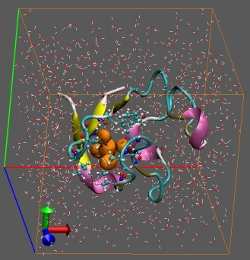 We calculate the redox potential and reorganisation free energy for molecules in complex environments. In particular we elucidated the role of the environment (solvent, protein scaffold) and its H-bond network on the electrochemical properties of several systems such as quinones and metalloproteins. Further works involves electrochemical properties of solid/liquid interfaces. For more information, please contact
We calculate the redox potential and reorganisation free energy for molecules in complex environments. In particular we elucidated the role of the environment (solvent, protein scaffold) and its H-bond network on the electrochemical properties of several systems such as quinones and metalloproteins. Further works involves electrochemical properties of solid/liquid interfaces. For more information, please contact 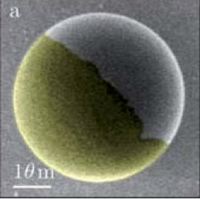 Dynamical collective behavior observed in, e.g., schools of fish and flocks of birds can often be described with simple models of so-called self-propelled particles. Even complex behavior can be reproduced by simple rules that are followed by all individuals (e.g., follow your neighbors but do not bump into them). On the microscale, both bacteria and colloidal particles have emerged as model systems to study a wealth of different phenomena such as swirling, swarming, and turbulence.
Dynamical collective behavior observed in, e.g., schools of fish and flocks of birds can often be described with simple models of so-called self-propelled particles. Even complex behavior can be reproduced by simple rules that are followed by all individuals (e.g., follow your neighbors but do not bump into them). On the microscale, both bacteria and colloidal particles have emerged as model systems to study a wealth of different phenomena such as swirling, swarming, and turbulence. 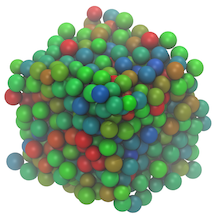 Most liquids (including water) can be supercooled below their melting temperature and stay in the liquid state. The reason is the presence of a free energy barrier that the system has to overcome in order to crystallize. But some liquids never crystallize and at some temperature fall out of equilibrium. They form what we call a glass, a substance that macroscopically appears as a rigid solid but which microscopically is still disordered like the liquid. A comprehensive theory describing this state of matter is still missing and is one of the major challenges in condensed matter science.
Most liquids (including water) can be supercooled below their melting temperature and stay in the liquid state. The reason is the presence of a free energy barrier that the system has to overcome in order to crystallize. But some liquids never crystallize and at some temperature fall out of equilibrium. They form what we call a glass, a substance that macroscopically appears as a rigid solid but which microscopically is still disordered like the liquid. A comprehensive theory describing this state of matter is still missing and is one of the major challenges in condensed matter science. 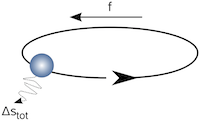 The extraction of useable work from heat has fueled the industrial revolution of the 18th century, the scientific basis of which is provided by classical thermodynamics. Although thermodynamics can be justified by statistical arguments, it is still concerned with average values due to the vast number of degrees of freedom that comprise a macroscopic body. Quite in contrast, machines on the microscale are faced with fluctuations that are large. Our very lifes depend on such machines (e.g., proteins) to work properly. Stochastic thermodynamics is a generalization of thermodynamic notions such as work and heat to include fluctuations. In particular, the probability distributions of these quantities are not arbitrary but respect certain symmetries collectively called fluctuation theorems.
The extraction of useable work from heat has fueled the industrial revolution of the 18th century, the scientific basis of which is provided by classical thermodynamics. Although thermodynamics can be justified by statistical arguments, it is still concerned with average values due to the vast number of degrees of freedom that comprise a macroscopic body. Quite in contrast, machines on the microscale are faced with fluctuations that are large. Our very lifes depend on such machines (e.g., proteins) to work properly. Stochastic thermodynamics is a generalization of thermodynamic notions such as work and heat to include fluctuations. In particular, the probability distributions of these quantities are not arbitrary but respect certain symmetries collectively called fluctuation theorems.  Repeat protein domains are formed by tandem arrays of repeating structural units, constitute about 20% of the eukaryotic proteome, mediating protein-protein interactions and acting as mechano-transductors. As such they may represent the basis for the construction of mechanical nanodevices. In collaboration with experimental groups in the field, we have been working on simplified models of repeat proteins which explains both the thermodynamics and the kinetics of folding of this class of proteins. We have also been carrying out atomistic molecular dynamics (MD) simulations of several repeat protein systems to study their folding behavior and their mechanical characteristics when subjected to external pulling forces. If you are interested, please contact
Repeat protein domains are formed by tandem arrays of repeating structural units, constitute about 20% of the eukaryotic proteome, mediating protein-protein interactions and acting as mechano-transductors. As such they may represent the basis for the construction of mechanical nanodevices. In collaboration with experimental groups in the field, we have been working on simplified models of repeat proteins which explains both the thermodynamics and the kinetics of folding of this class of proteins. We have also been carrying out atomistic molecular dynamics (MD) simulations of several repeat protein systems to study their folding behavior and their mechanical characteristics when subjected to external pulling forces. If you are interested, please contact 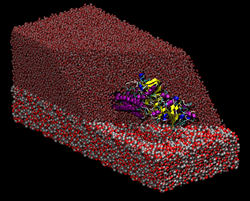 Transport of nutrients to peripheral tissues and healing of damaged blood vessels are among the most important functions of blood. These functions involve the action of a series of proteins some of which are found in large amounts in the blood circulation. Fibrinogen is a multiprotein complex which, when activated, aggregate to form fibrin, a net-shaped molecular formation which is fundamental for the coagulation of blood following, i.e, a wound or when an extraneous body comes into contact with blood (i.e., graft implants). Thus, adsorption of fibrinogen on material surfaces play an important role in viability of those materials for implants.
Transport of nutrients to peripheral tissues and healing of damaged blood vessels are among the most important functions of blood. These functions involve the action of a series of proteins some of which are found in large amounts in the blood circulation. Fibrinogen is a multiprotein complex which, when activated, aggregate to form fibrin, a net-shaped molecular formation which is fundamental for the coagulation of blood following, i.e, a wound or when an extraneous body comes into contact with blood (i.e., graft implants). Thus, adsorption of fibrinogen on material surfaces play an important role in viability of those materials for implants.  Our activity focuses on the development and application of methods for the identification of the folding transition state of peptides and, more in general, for the complete characterization and representation of the dynamics of peptides by using atomistic molecular dynamics simulations . This research effort is based on the application of concepts like kinetic networks (figure on the left) and Markov models to the trajectory data of peptides collected by MD simulations. Results from this line of research are validated against available experimental data on the kinetics of folding of peptides (folding/unfolding rates, phi values). If you are interested, please contact
Our activity focuses on the development and application of methods for the identification of the folding transition state of peptides and, more in general, for the complete characterization and representation of the dynamics of peptides by using atomistic molecular dynamics simulations . This research effort is based on the application of concepts like kinetic networks (figure on the left) and Markov models to the trajectory data of peptides collected by MD simulations. Results from this line of research are validated against available experimental data on the kinetics of folding of peptides (folding/unfolding rates, phi values). If you are interested, please contact 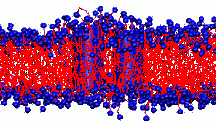 All living things depend on membranes. Their basic structure is provided by lipid bilayers, which self-assemble spontaneously in water due to the amphiphilic character of lipid molecules - they contain both hydrophilic and hydrophobic units. In our group, we are interested in generic properties of such amphiphilic bilayers.
All living things depend on membranes. Their basic structure is provided by lipid bilayers, which self-assemble spontaneously in water due to the amphiphilic character of lipid molecules - they contain both hydrophilic and hydrophobic units. In our group, we are interested in generic properties of such amphiphilic bilayers.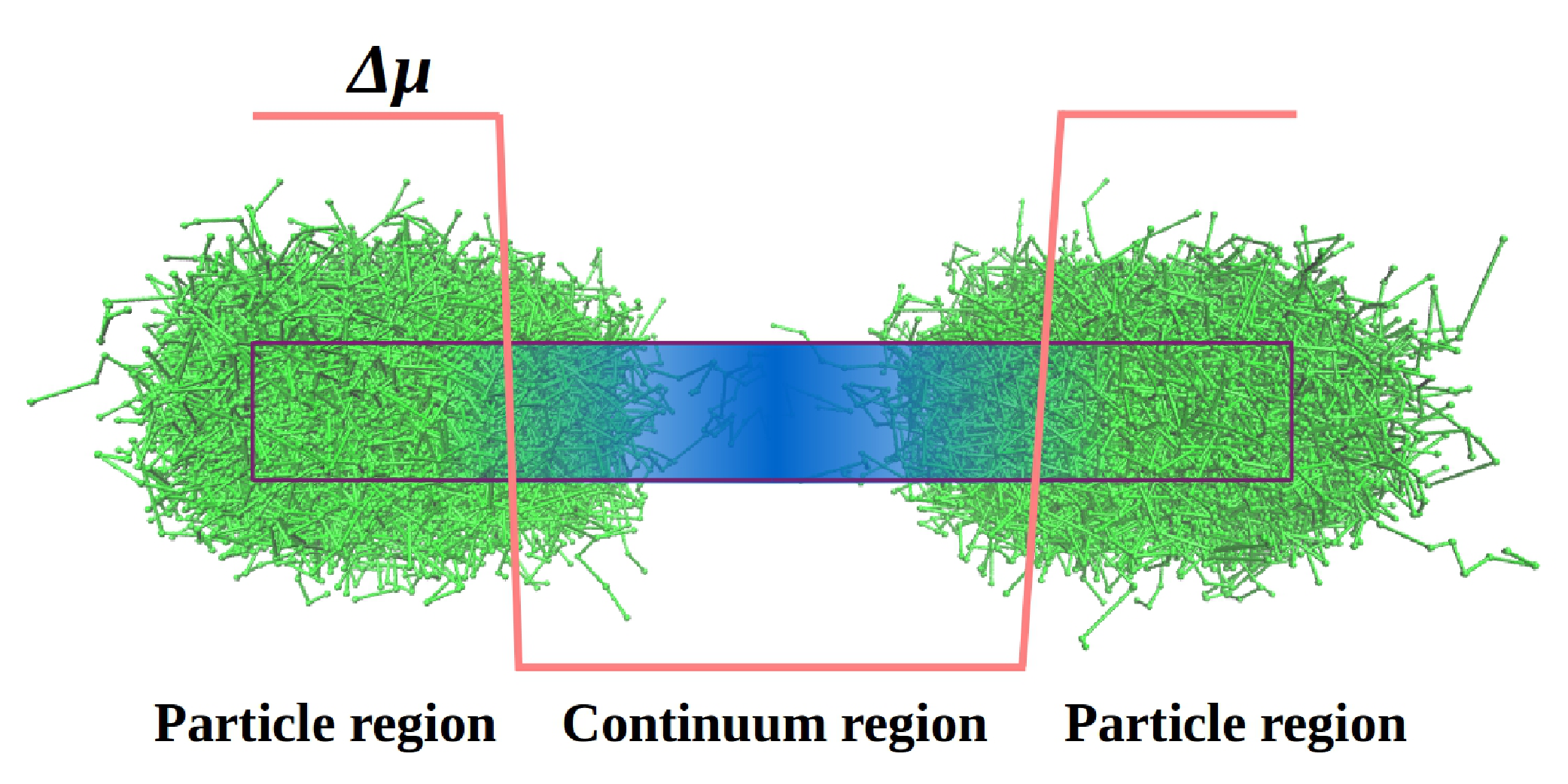 The so-called 'self-consistent field' (SCF) theory is one of the most successful density functional theories fo inhomogeneous polymer systems, which allows to calculate the local structure of dense blends at an almost quantitative level (see
The so-called 'self-consistent field' (SCF) theory is one of the most successful density functional theories fo inhomogeneous polymer systems, which allows to calculate the local structure of dense blends at an almost quantitative level (see 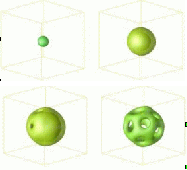 Melts of one or more kinds of polymers exhibit a wealth of diverse phases whose geometric properties make them interesting systems not only for condensed matter research, but for industrial applications, as well. Specifically, block copolymers made of chemically incompatible monomers (say, A and B) exhibit microphase separation, thus forming regular nanoscale patterns of varying complexity. In solvent, they self-assemble to nanoparticles or vesicles which can be used, e.g., as nanocontainers.
Melts of one or more kinds of polymers exhibit a wealth of diverse phases whose geometric properties make them interesting systems not only for condensed matter research, but for industrial applications, as well. Specifically, block copolymers made of chemically incompatible monomers (say, A and B) exhibit microphase separation, thus forming regular nanoscale patterns of varying complexity. In solvent, they self-assemble to nanoparticles or vesicles which can be used, e.g., as nanocontainers. 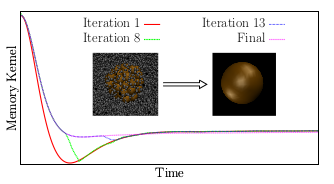 In soft matter, the separation of time scales is often incomplete and memory effects become important. We develop coarse-graining strategies for such situations, using the example of colloidal dispersions. We develop methods to reconstruct memory kernels in simple and complex fluids (e.g., electrolyte fluids). Our goal is to construct implicit solvent models that include memory effects and can be used for equilibrium and non-equilibrium simulations. In this context, we also develop algorithms for the efficient simulation of coupled generalized Langevin equations. For more information, please contact
In soft matter, the separation of time scales is often incomplete and memory effects become important. We develop coarse-graining strategies for such situations, using the example of colloidal dispersions. We develop methods to reconstruct memory kernels in simple and complex fluids (e.g., electrolyte fluids). Our goal is to construct implicit solvent models that include memory effects and can be used for equilibrium and non-equilibrium simulations. In this context, we also develop algorithms for the efficient simulation of coupled generalized Langevin equations. For more information, please contact 